e-SPAN Newsletter v029: What Can it Mean to Revolutionize Architecture?
What Can it Mean to Revolutionize Architecture?
ARCHITECTURE X REVOLUTIONS X RESOLUTIONS
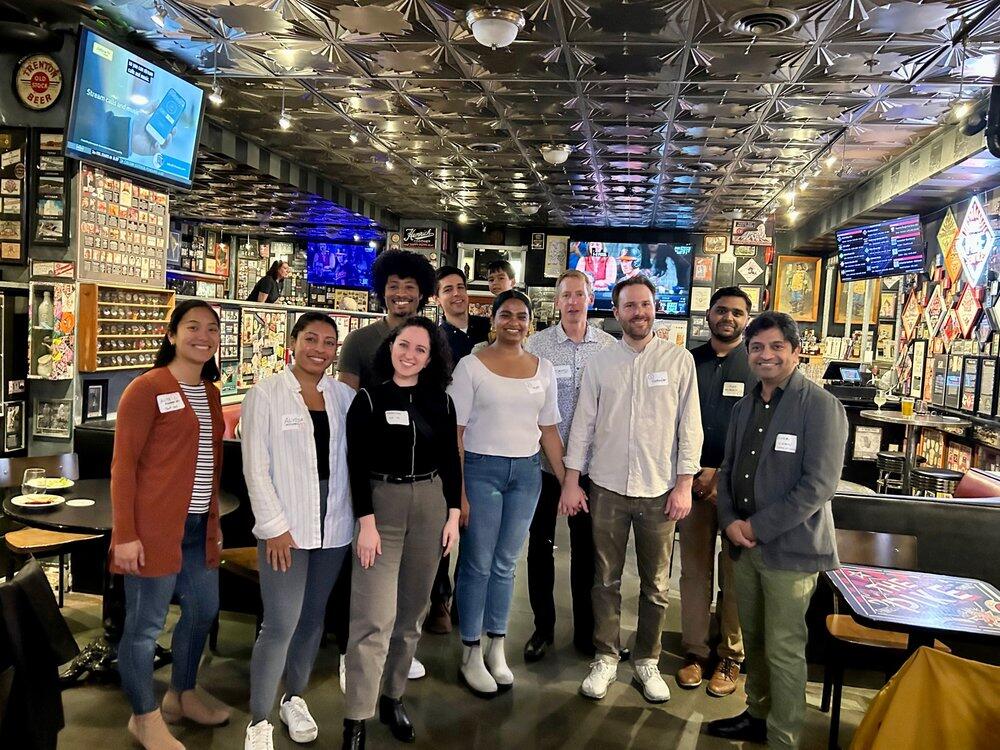
Alumni pose with head of school Omar Khan (right) during an alumni event in Seattle.
Dear Carnegie Mellon Architecture Community,
This year the theme for our Public Programs is Revolutions/Resolutions.
This builds on the school’s focus on developing new pedagogies that equip our students to address the pressing issues of tomorrow. To help us understand and contextualize modes for creating radical change, the series addresses how concerns about inclusion intersect with social, political and technological changes. It’s revisiting historical events but also looking to future modes of actions. It’s examining the role of architecture as an enabler, deterrent and symbol in revolutionary change. We’re hosting historians, activists, architects, designers, teachers and filmmakers to help us unpack the complex relationship between the necessity of change and the difficulty in bringing it to resolution.
The current political climate and the two wars in Israel/Gaza and Ukraine have put a huge emotional toll on our students, faculty and staff. I would be remiss to not recognize this context within which our Public Programs series is unfolding. The resort to violence as a means to bring about change or address our problems has to be unequivocally condemned. This is well represented in the history of revolutionary actions, and we must reject it as a mode to adopt for the future.
The Public Programs series, in contrast, provides amazing examples of how spaces for learning and radical inclusion can be developed and reproduced for the future. I encourage you to follow the series over the 2023-24 academic year in person. You may also want to visit our archive of past speakers, which is vast and a great resource for continued education.
We are also continuing our e-SPAN series featuring alumni interviews, connecting the work that they are doing to the issues we are discussing at the school. This month we are thrilled to feature Robert Ferry (B.Arch ‘98) and Elizabeth Monoian (MFA ‘00) and their firm Land Art Generator (LAGI), and Stephen Wilder (Master of Science in Architecture ‘04) and his firm Think Wilder Architecture. Both are working across the concerns of community and climate change and how architecture can enable positive action.
I had the pleasure to visit alumni in Seattle and Portland this past month. This was my first trip to the Pacific Northwest as head, and I was hugely encouraged by the work that our alumni are doing there. We are seeing a greater number of students coming to us from the region and returning there to work. I hope to build our network through our alumni and provide our students with internship and employment opportunities. In meeting with firms, I was reminded of the increasing importance of research in the design process—and the uniqueness of our programs, which continue to centralize research throughout students’ education.
As always, please keep in touch, and let us know of alumni we should profile. We always look forward to hearing from you.
Omar Khan
Head of School
Image

| Carnegie Mellon Architecture alumni pose with head Omar Khan (right) and faculty member Erica Cochran Hameen (second from left) in Portland, Oregon. |
The Architect is In: Stephen Wilder (Master of Science in Architecture '04)

“Anyone with the privilege to influence the lives of other people needs to decide what kind of revolution to be a part of. Are you reworking a broken system? Setting new standards? Creating ways to involve and respond to everybody in the room?”
These questions drive the practice of Stephen Wilder (Master of Science in Architecture ‘04), founder and principal of Think Wilder Architecture.
The revolutionary principles underlying Wilder’s community-centered design excellence include consistent authenticity and transparent availability.
His work—which spans the gamut from large, mixed-use developments to small, neighborhood-based cultural spaces—puts him in rooms with everyone from powerful decision-makers to dedicated community activists. In those rooms, he deploys a huge range of personal and educational experience to ensure that everyone’s voice is heard and becomes part of the design solution.
“I seek to connect genuinely with people,” he says. “I learned this from my grandfather, a retired sergeant and community chef, and my mother, a social worker. As an undergraduate at Howard University, I supplemented architecture coursework with sociology and psychology classes to better understand how people think and work.”
Wilder grew up in Harlem and attended elite universities, so he is at ease in a range of environments—though he’s quick to point out that any architect, regardless of background, can revolutionize the design process with personal authenticity.
“The architect’s goal should be trust, which comes from transparency, not from communicating that you’re there to save the day. Any client can distinguish between an architect trying to represent power and an architect trying to solve problems,” he observes.
Wilder’s unconventional availability engenders that trust. Think Wilder occupies a storefront in Harlem and now an office in Newark. His practice, then, is part of what he calls the “pulse of the neighborhood,” making him available not only to clients but to neighbors who might wonder what architecture can do. Think Wilder welcomes walk-in visitors, who might range from future clients to high-school students interested in a design career. Wilder and his colleagues bring availability and transparency to every project, exploring the neighborhoods around their project sites, talking with community members and coming to be “known, and even loved” by their clients, he says.
Wilder’s commitment to authenticity in the service of excellence has developed over the course of his career. His first large-scale project was the Station at Grant Avenue (“originally called The Muse, because we’re big dreamers”), a 90-unit workforce housing and industrial development in Plainfield, New Jersey.
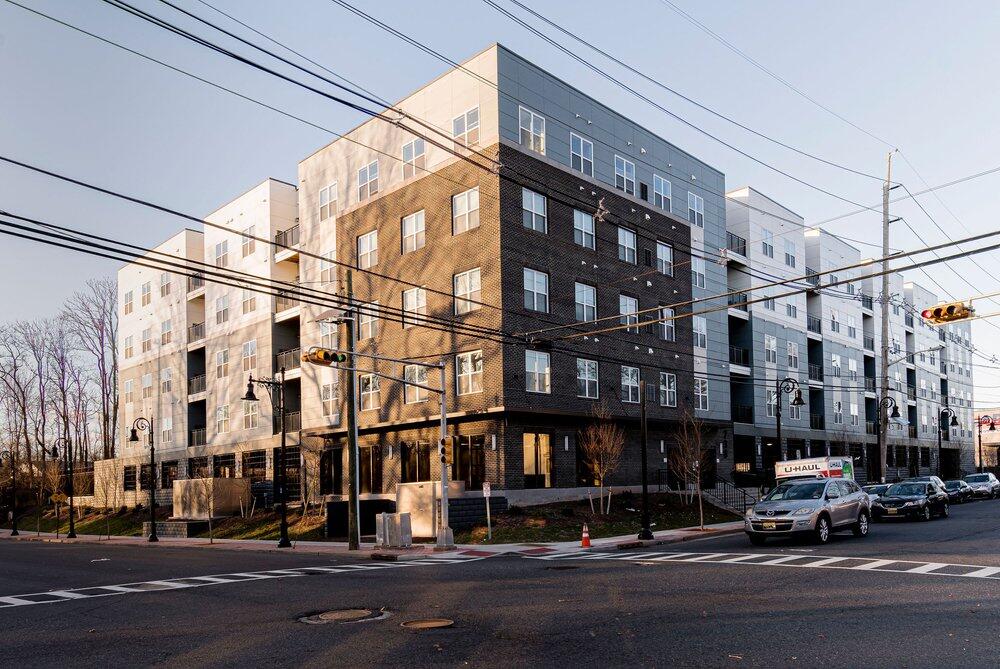
Station at Grant Avenue. Photo courtesy of Stephen Wilder
With Wilder’s involvement, what could have been an uninspired, run-of-the-mill development became a revitalizing community hub for an ignored neighborhood. In the project’s discovery phase, Wilder learned that the proposed closing of a nearby contracting-supply store would not only siphon away dozens of local employees’ jobs but also the necessary resources for continued building in the area. His design for the Station at Grant Avenue, then, included remediating a nearby brownfield to become a new industrial space for the supplier, which now continues to serve the growing neighborhood.
That project sped his firm’s development and allowed him to hone his professional priorities, which center on creating meaningful cultural spaces—like Newark Symphony Hall, an esteemed historic venue undergoing significant restoration and renovation with the help of Think Wilder.
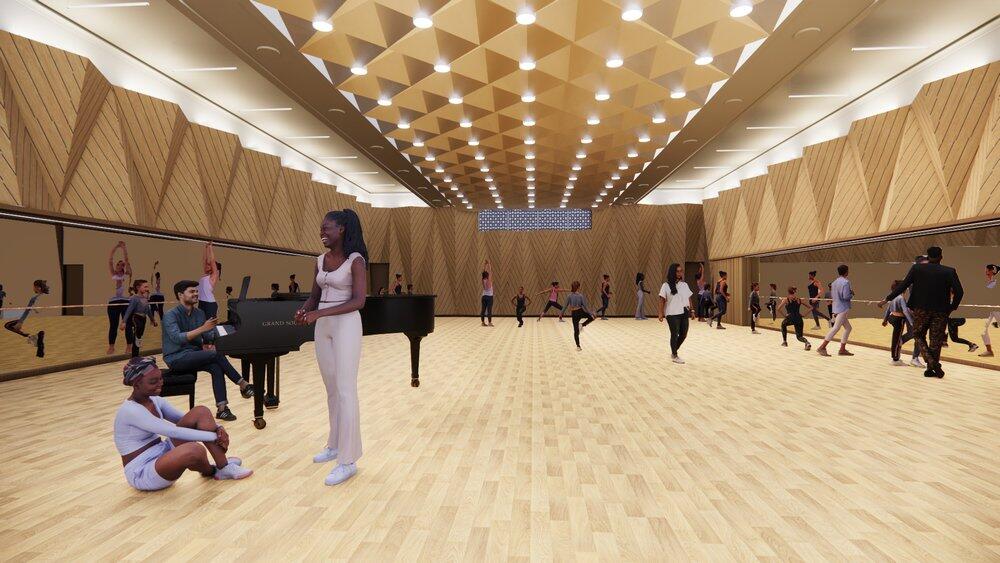
A rendering of a fourth-floor dance studio in Newark Symphony Hall. Image courtesy of Stephen Wilder.
Most recently, he’s crystallized his values by donating design services to rehabilitate the Brooklyn headquarters of the historic United Order of Tents. “The Tents had already been working hard to restore their building’s legacy when I first met with them,” says Wilder. “During our meeting, I was so moved by their story and hardships, I realized I could become another element of their success. Both their history and their importance to their community’s success are clear. Offering to support them was a no-brainer.”
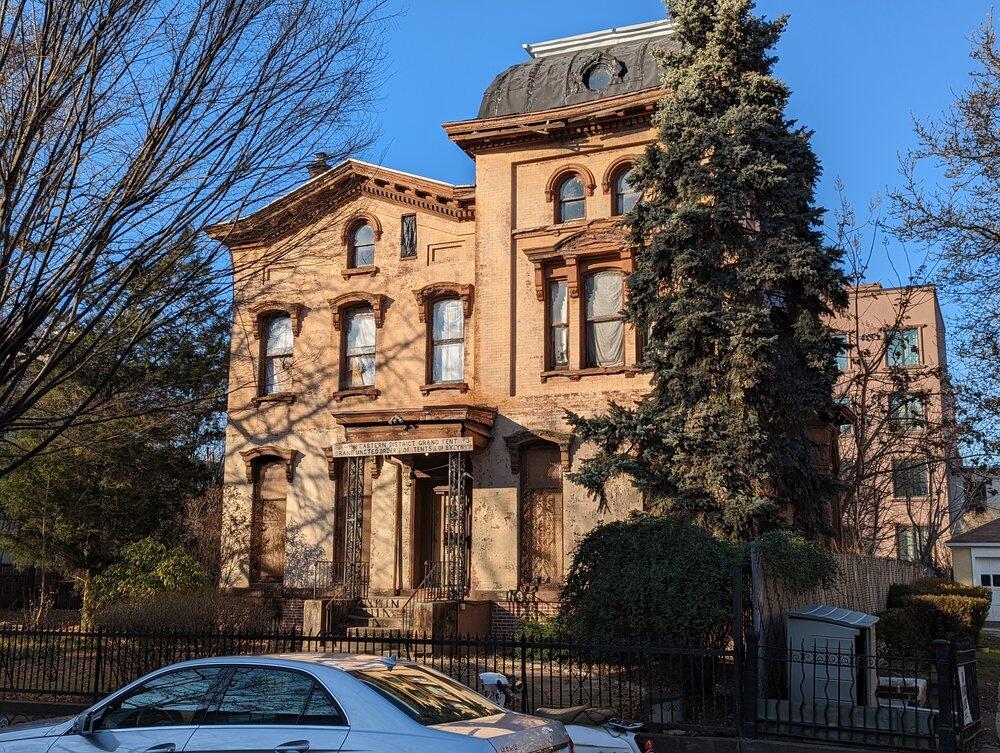
The Brooklyn headquarters of the historic United Order of Tents. Photo courtesy of Stephen Wilder.
When asked to lend advice to architecture students and young professionals, Wilder is quick to point out that his opportunities and success did not arrive overnight. “If you intend to go into business for yourself—as I always wanted to do—learn as much as you can now about professional practice,” he recommends. He extols the importance of trial and error, of patience, and of spinning small wins into larger opportunities.
Such work is extraordinarily time- and energy-consuming, and Wilder cautions young architects to pursue the discipline only if they truly love it. Because solving problems and creating memorable community spaces are sources of joy for him, he doesn’t see a separation between “work” and “life”—but he acknowledges that, for many, this can be a pitfall. “Make sure your loved ones understand what architecture is,” he counsels, “and invite them to join you in that work.”
He continues: “It’s such a privilege to be an architect. Someone is trusting you to design their space!—something as small as a bathroom or as large and complicated as a city. There’s so much pressure there, but it’s such a privilege. The pleasure of completing a project for a community is such a gift.”
The New Vanguard: Elizabeth Monoian (MFA '00) and Robert Ferry (B.Arch '98)
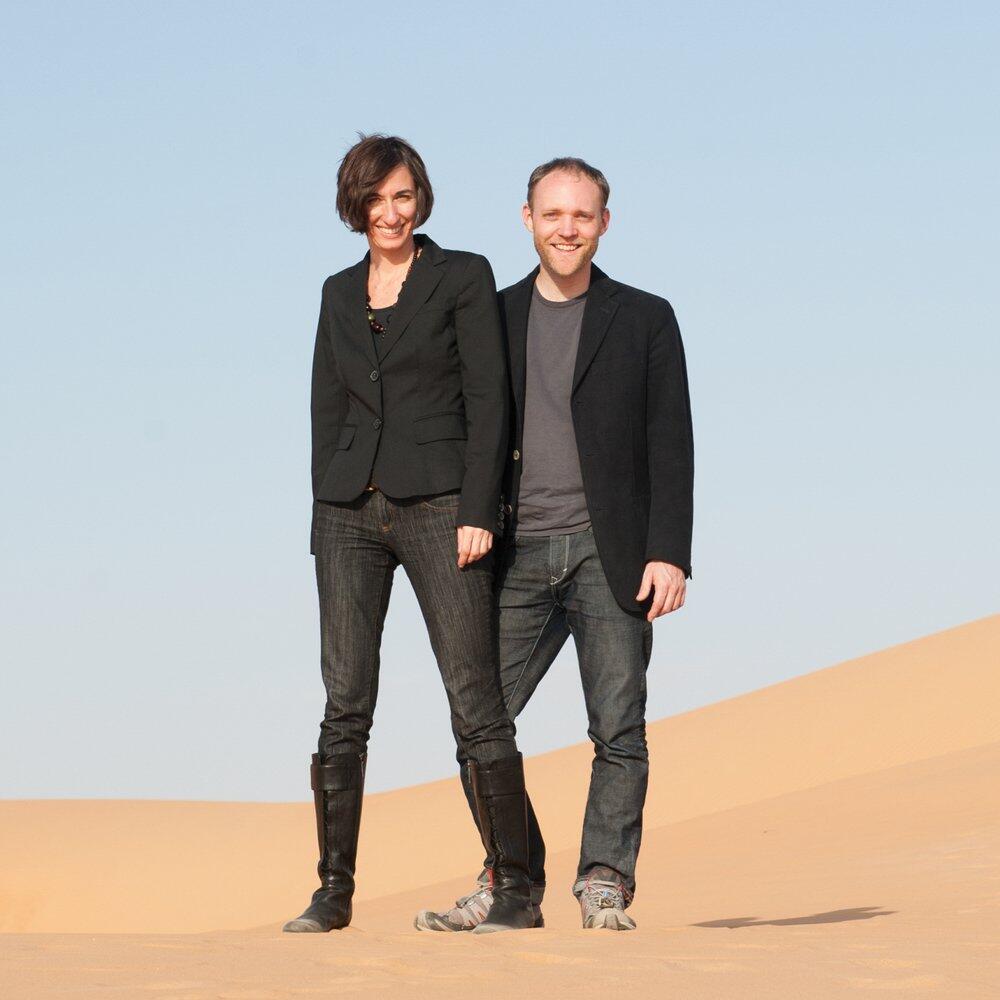
Toni Cade Bambara famously asserted that the artist must “make the revolution irresistible.”
Elizabeth Monoian (MFA ‘00) and Robert Ferry (B.Arch ‘98), founders and principals of the Land Art Generator Initiative (LAGI), are making the renewable-energy revolution beautiful, delightful—even sexy.
“The best motivator for climate action is desire,” says Ferry. “People will fight for a good future that they can imagine.”
The pair met in 2006, well after each had graduated from CMU, and immediately connected over their concern about climate action. Ferry was an architecture student in the 1990s, when Carnegie Mellon Architecture’s sustainable-design principles were already highly advanced, so he and Monoian knew that technical climate solutions were available and well developed.
But they noticed—and, frankly, understood—many people’s “not in my backyard” response to the aesthetics of most of those solutions. Since traditional energy infrastructure had long been hidden or remote, they explain, the public was unaccustomed to seeing it. And most renewable-energy infrastructure was utilitarian and off-putting in the extreme: “Think mindless rows of blue panels on a gravel field devoid of life, set behind a chain-link fence with barbed wire and security cameras,” Monoian elaborates. “Sure, such projects help decarbonize the grid, but they also do a disservice to the overall transition movement by insinuating that these infrastructures are a kind of necessary evil, something we have to live with.”
She and Ferry perceived an existential need to inspire people toward not just the utility but also the exhilaration of climate action, “the greatness of a world that no longer burns carbon for energy.”
They caution against repeating the mistakes of last century’s urban renewal projects, which left scars on unempowered communities. We must not, says Ferry, “pave over the nation with solar panels like we did with highways.” Instead, he’s inspired by the Works Progress Administration projects of the 1930s, which remain a source of pride—“infrastructure gilded with culture.”
From this—a shared commitment to make renewable energy beautiful and engaging—LAGI and its signature design competition were born. The international competition, held eight times so far, has yielded over a thousand unique designs for renewable energy infrastructure that doubles as public art.
The best of these designs, Ferry and Monoian say, “are those that discover an elegant solution, with a profoundly beautiful concept, that incorporates technology already field tested and available in the market.”
In the competition and their own design work, Monoian and Ferry have demonstrated time and again that elegance and beauty are generative. “The zero-sum message that we must sacrifice art and culture for the sake of a habitable planet,” stresses Ferry, “is just not true. Our mission has been to demonstrate an alternative vision, one where a post-carbon world is also one of human thriving and wonder. Every renewable energy installation is an opportunity to create beautiful places for people.”
LAGI itself has created a number of “beautiful places” that showcase its vision: Its Solar Murals bring colorful photovoltaic murals to neighborhoods. Its Arco del Tiempo (LAGI artwork by Riccardo Mariano), to be installed in Houston in 2024, will be an interactive public artwork, shaded outdoor space, and a permanent community solar installation generating around 400,000 kilowatt-hours (kWh) of electricity annually. And in Pittsburgh, LAGI led an Art+Energy Camp with a group of Homewood youth who undertook a comprehensive study of the region’s energy infrastructure before creating a neighborhood installation of their own, the Renaissance Gate.
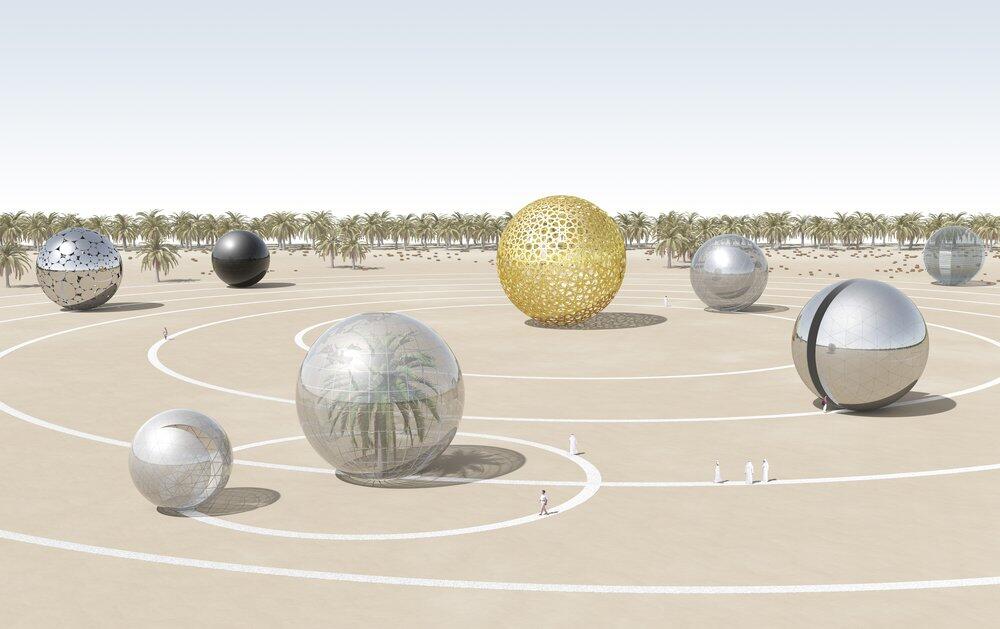
Solar (ECO) System : December 2nd, 1971
A submission to the 2010 Land Art Generator Initiative design competition for Dubai and Abu Dhabi
This was the very first project to be uploaded to our competition website in 2010!
Artist Team: Antonio Maccà, Flavio Masi Artist Location: Padova, Italy Energy Technologies: various types of photovoltaic panels of differing reflective hues Annual Capacity: 1,000 MWh Designed for Site #3 in Abu Dhabi, on Airport Road near Masdar City
The project is an artistic interpretation of the Solar System and marks the position of the planets corresponding to the configuration of the Solar System on December 2nd 1971, the day in which the United Arab Emirates was founded. The environmental installation is a metaphor of the Seven Emirates, represented in the form of a Sun with six planets. The artwork is also meant to create a new iconic sun for the City of Abu Dhabi: the astronomic Sun radiating energy to the new photovoltaic sun, which will generate light and electricity for the city.
The PV sun works as the attracting element and symbolizes the unity and infinity of the cosmos. The endless geometrical pattern of the golden surface, with its timeless perfection and purity, represents the starry sky and creates a spherical motif of both light and shade. The PV sun is to be completed by means of LEDS that will light up its skin throughout the night. The spheres are all different, varying in structure, dimension, color, transparency degree and photovoltaic technology.
The Earth is the only place in the universe where life is known to exist: life on earth is therefore symbolized by an already existing tree, around which will be constructed a photovoltaic greenhouse with the serigraphy of the continents. The Moon, its satellite, is endowed on the surface with an opening in shape of a Crescent. The planets, like pavilions, can host entertaining and educational facilities, such as temporary exhibitions or public activities, in order to create a new place of collective identification and a fascinating cultural site.
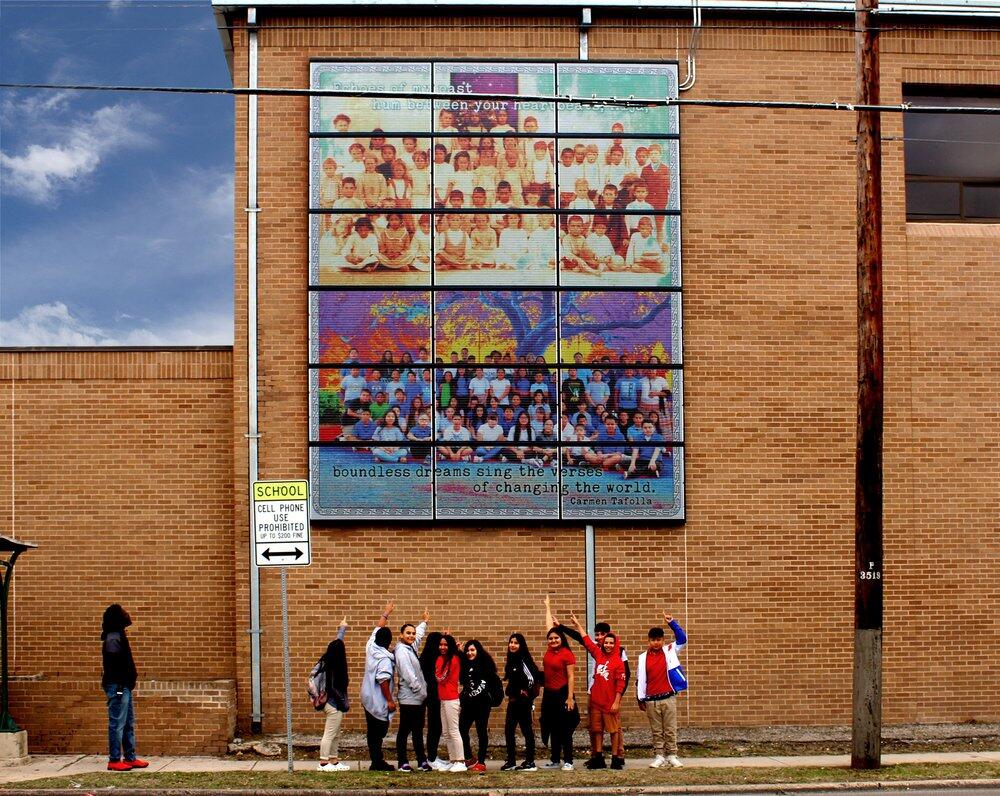
En Aquellos Tiempos Fotohistorias del Westside
Students pose in front of the Land Art Generator Initiative Solar Mural Installation on the JT Brackenridge Elementary School in San Antonio, TX that features their class below an image of the class of 1906, showing the continuity of life in the neighborhood over more than a century. Original photo by Imgard Rop.
The design of this Land Art Generator Solar Mural installation in San Antonio is the result of a collaborative process that began with Land Art Generator workshops at the elementary school with Mr. Vega’s 5th grade class, and with elders of the community who shared their stories. The outcomes of those workshops informed local artist Adriana M Garcia who incorporated text from a local poet, Carmen Tafolla, into her visual art.

Alumni News & Updates
To have your alumni news featured, please email Kristen Frambes at kframbes@andrew.cmu.edu with a brief description and link to more information.
Dr. Ming Qu, PhD-BPD ‘08, professor of civil engineering at Purdue University, has been selected as a Fulbright U.S. Scholar for 2023-24 in Japan. The Fulbright Scholar Awards are highly competitive and prestigious fellowships that provide unique opportunities for scholars to teach, conduct research and carry out professional projects worldwide.
Dr. Lola Ben-Alon, PhD-AECM ‘20, Assistant Professor at Columbia GSAPP, with the Natural Materials Lab, organized The Material Variance Symposium on Sep. 19, 2023. The symposium connects material design researchers, building scientists and artists to discuss the reciprocal impacts of species and form, and the defiance against refinement, exploitation and technocratic establishments.